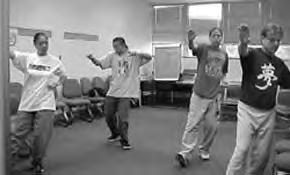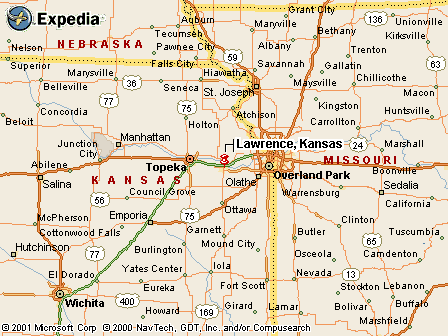|
|
Canku Ota |
|
|
(Many Paths) |
||
|
An Online Newsletter Celebrating Native America |
||
|
July 14, 2001 - Issue 40 |
||
|
|
||
|
Students Find Strong Connections in Tai Chi |
||
|
by Mary Pierpoint Indian Country Today Staff-July 4, 2001 |
 LAWRENCE,
KS - Upward Bound students at Haskell Indian Nations University are finding the ancient art of tai chi isn't all
that far from the values of their own Native American roots. LAWRENCE,
KS - Upward Bound students at Haskell Indian Nations University are finding the ancient art of tai chi isn't all
that far from the values of their own Native American roots.Bill Douglas, a 20-year veteran of the art of stress relief, is teaching students this summer to control their stress and even their anger. He told them an added bonus in learning tai chi is that school work will become easier as they learn to use both sides of their brain during their sessions of the ancient art. Douglas said he always thought there was a connection between the cultures of China and Native Americans, but after teaching his first American Indian students tai chi, he firmly believes it. "I've always been curious about Native American culture because my great-great-grandmother was Cherokee," Douglas said. "I really didn't really know much about that or even my Celtic heritage, but when I started getting involved with tai chi, I met a lot of people who had experienced similar wisdom from other cultures." One of his favorite authors found a strong connection in the web of life between Native American culture and others around the world. Douglas said that the idea fit right in to the medicine wheel and the red, black, yellow and white colors he was learning about from his Native American students. "When I had this opportunity, I took it. I didn't know how in touch with the old wisdom these kids were going to be. But, as I've gone through this, I've found that a lot of these kids have really listened to their grandparents about the web of life and the connections. It gave me an opportunity to give something that is complementary to the traditions that a lot of these kids come from, especially those who come from reservations and have a strong contact with the past." Students aren't the only ones to benefit from the exchange of cultures. Douglas said he found a whole new world opened up to him. "It has been a growing experience for me because I have had an opportunity to see things that I hadn't been exposed to before. It has really opened my mind to a whole different level of wisdom that I hadn't had access to before." One thing that struck Douglas is the ease with which students learned the art of tai chi, "a highly accelerated rate. I've never had classes that pick up the movements as easily or as naturally as these students do," he said. As the class resumes, Douglas and his students become visibly relaxed as they work through the slow, methodical movements of tai chi. "This will teach you to think with both sides of your brain," Douglas tells them. "You will find that your problem-solving skills will improve as you learn to think and use both sides of your brain." There is no emotion on the students' faces, just a relaxed concentration that appears to put them in a world of their own, aware of Douglas' presence but too relaxed to acknowledge him. Slowly they make their way across the room, "pulling the tail of the bird, passing the monkey," their graceful movements relaxing all who watch them. The small class winds down as more students arrive for the next session. Three students who just completed the class are serene and energized, ready to continue their day. Douglas said it is that combination of serenity and energy that has attracted people throughout the world to the art of tai chi, but added he can see even more benefit for the young students he works with. Wetg-Ke-Te, a Sac & Fox student, said he sees tai chi as a way to manage anger as well as stress. Wetg-Ke-Te was exposed to tai chi through an uncle and his participation in the class has him planning to stay with it. Janelle Gonzales, facilitator for Upward Bound said she found relaxation one of the greatest benefits to tai chi. "It's nice as a stress reliever." Student Cedrick Yazzie said he is finding out about a new culture, one he hadn't been exposed to before. He wasn't sure tai chi would be a permanent fixture in his life. "I wanted to learn just to see how it was. In my culture we don't learn this stuff. My family said that we ran three miles each morning, so that is what I do instead of other stuff. That is my culture way, but I am learning this just for fun." Although Douglas said he is glad his students are having fun with the class, he hopes they walk away with the same amount of knowledge he is gaining. "One of the things that everybody gets from this is the tools to manage stress. It's a problem that all of us have because life is changing so fast. A lot of the challenges these kids are facing are school and jobs and getting ready for college. They are getting stress management tools that they can use for the rest of their lives ... one of the tools that I find is really powerful for me personally and for the kids is that they are starting to see global wisdom. We are starting to see connections between tribal wisdom and Chinese culture." The concept of the medicine wheel has been a strong connection for students and teacher. "One of the things that I have found intriguing since I started this program is the medicine wheel, how it has the four colors that represent the original four colors of the people on earth. It takes the wisdom of all people to create a healthy wheel of life. It is so interesting, the concepts from the Far East and the concepts here. They had no communication that we know of, yet they saw the same insights. "It shows us that these really deep insights into life aren't superstitions because people from all over the world once understood it." |
|
|
|
INDIAN NATIONS UPWARD BOUND |
|
|
||
|
|
||
| Canku Ota is a free Newsletter celebrating Native America, its traditions and accomplishments . We do not provide subscriber or visitor names to anyone. Some articles presented in Canku Ota may contain copyright material. We have received appropriate permissions for republishing any articles. Material appearing here is distributed without profit or monetary gain to those who have expressed an interest. This is in accordance with Title 17 U.S.C. section 107. | ||
|
Canku Ota is a copyright © 2000, 2001 of Vicki Lockard and Paul Barry. |
||
|
|
|
|
|
The "Canku Ota - A Newsletter Celebrating Native America" web site and its design is the |
||
|
Copyright © 1999, 2000, 2001 of Paul C. Barry. |
||
|
All Rights Reserved. |
||

